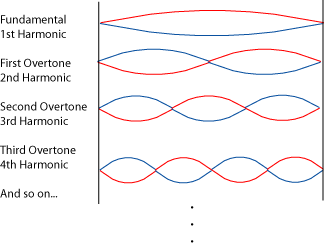String Vibration
String instruments form a versatile family, producing sound by vibrating strings.
Categories include bowed instruments like the violin,
plucked instruments such as the guitar, and
struck instruments like the piano.
Varied in shape and playing techniques, they offer a rich array of tones, expressing emotions and cultural diversity worldwide.
The ethereal beauty of stringed instruments, from the delicate tones of a violin to the resonant chords of a guitar, emerges from the intricate dance of vibrating strings. Understanding the physics behind this phenomenon unravels the secrets of these instruments and enriches our appreciation of their musical magic.
At the heart of string vibration lies the fundamental principle of wave mechanics. When a musician plucks, bows, or strikes a string, they impart energy to it, initiating a cascade of events that transform that energy into audible sound. The string, typically made of materials like nylon, steel, or gut, undergoes a series of complex vibrations.
The process begins with the initial displacement of the string from its equilibrium position. This displacement creates tension in the string, acting as a restoring force attempting to bring the string back to its resting state. The interplay between tension and displacement sets the string into motion, and it starts to oscillate.
The motion of the string can be visualized as a series of waves. These waves travel along the length of the string, creating areas of compression and rarefaction. The compression zones represent points where the string is displaced upward, while the rarefaction zones depict points of downward displacement. Together, these regions form a standing wave pattern, giving the vibrating string its distinctive shape.
The frequency of these standing waves, determined by factors like tension, length, and mass per unit length of the string, corresponds to the pitch of the sound produced. The fundamental frequency establishes the primary pitch, while higher-order harmonics contribute to the overall tonal complexity.
The length of the vibrating portion of the string plays a crucial role in shaping the pitch. Stringed instruments often feature a fingerboard or frets that allow the musician to alter the effective length of the vibrating section. By pressing a string against a fret, the musician shortens the length and increases the frequency, producing higher pitches.
As the string vibrates, it interacts with the surrounding air molecules, creating compressions and rarefactions that propagate as sound waves. These waves travel through the air until they reach our ears, where they are interpreted by the brain as musical notes.
The quality of sound produced by a vibrating string is also influenced by its amplitude, or the extent of its displacement. The amplitude determines the loudness or softness of the sound, allowing musicians to express dynamics and emotions through their playing technique.
The rich timbre of stringed instruments results from the interplay of various factors, including the material and thickness of the string, the shape and size of the instrument’s body, and the playing technique employed by the musician. From the crisp brilliance of a plucked harp string to the warm resonance of a bowed cello, each manifestation of string vibration carries a unique signature.
In conclusion, the enchanting world of string vibration weaves together physics, craftsmanship, and artistic expression. The vibrating string, governed by the laws of wave mechanics, transforms energy into music, inviting listeners into a realm where the ethereal and the tangible converge in harmonious melody.

